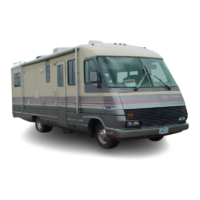28
Discovery, Discovery LXE, Pace Arrow, and Pace Arrow LXEt
The ignition switch must be on
to power the monitor. The Power
button on the monitor turns the
system on or off. Momentarily
press to turn the system on. Press
and hold to turn off.
Precautions:
Do not expose the monitor
to excessive heat or cold.
The monitor is not
waterproof.
Do not use abrasive
cleaning materials on
monitor.
Do not strike or drop
objects on the monitor.
To Use the System When
Driving:
Turn on the ignition.
Turn on the
monitor.
Use the camera
select switch to
select a camera
when the
turn signal is
inactive.
NOTE:
The rear vision system
will automatically activate
when the transmission is
placed in reverse.
Menu:
Select a feature from the
menu then use the Input (+)
and Dimmer (-) to adjust.
BACKING UP A MOTORHOME
Whether a long time owner
of recreational vehicles or just
starting out, backing up can be a
challenge. Following some simple
guidelines may help to reduce that
challenge.
When backing up, the driver
(pilot) should be comfortable using
the mirrors, the back-up camera
and the co-pilot’s directions
(ground guide) for assistance.
Practice backing up with the
co-pilot’s guidance in a large
unobstructed parking lot. Backing
up is a team effort. The backing
process should begin while the
motorhome is in forward motion.
Maneuver the motorhome to align
with the chosen site.
Aligning the motorhome with
the site after the backing process
begins may require more than one
attempt. When the motorhome is
properly aligned with the site, the
parking area will be visible in both
mirrors. Use road markings as
reference points when possible.
When pull-through sites are not
available, pick a solid, level site
on the left side for a better eld of
vision using the roadside mirror.
If the site is on the right, use the
curbside mirror for backing up.
Remain aware of blind spots.
Get out and walk the area prior
to backing in. Look for potential
hazards or obstacles that may
damage the motorhome. If the site
is satisfactory, prepare to back
in carefully. Have the co-pilot
provide guidance using the ve
hand signals. Use of walkie-
talkies will also aid in guidance.
The backup monitor may have a
one-way communication feature.
Have the co-pilot or spotter “speak
up” so directions can be given and
followed.
The co-pilot will perform just
as an important a job as the
driver. When guiding the driver,
the co-pilot should be located
safely at the left rear corner of the
motorhome, facing forward, while
remaining visible in the roadside
mirror at all times.
The co-pilot should make a
conscious effort to maintain
sight of the driver through the
roadside mirror as the motorhome
maneuvers. If the driver loses sight
of the co-pilot, stop backing up
until the co-pilot returns to view.
To avoid mishaps, the co-pilot
should be focused only on what
the driver is doing, with brief
observation moments.
If necessary, stop backing up so
the co-pilot can inspect other areas
or angles of concern. The driver
should receive directions only
from the co-pilot.
When the co-pilot is guiding
the driver, ve clearly dened
signals should be used, with
only one signal given at a time.
Flailing arms with indecisive
signals confuse the driver. Signals
should be given with purpose and
condence. Directional signals are
directing travel of the rear of the
motorhome.
If the desired direction is left,
the co-pilot points left. For
example: The co-pilot will use
their right arm and forenger
pointing distinctly left with arm
and nger held on a horizontal
plane, indicating desired direction
of travel of the rear of the
motorhome. The directional signal
given should remain steady until
the desired movement is complete.
Five Directional Signals:
1. Co-pilot uses left hand
and arm held horizontal,
with forenger pointing
right, to direct rear of
motorhome to the right.
2. Co-pilot uses right hand
and arm held horizontal,
with forenger pointing
left, to direct rear of
motorhome to the left.
080527d
REAR
CAM
LEFT
RIGHT

